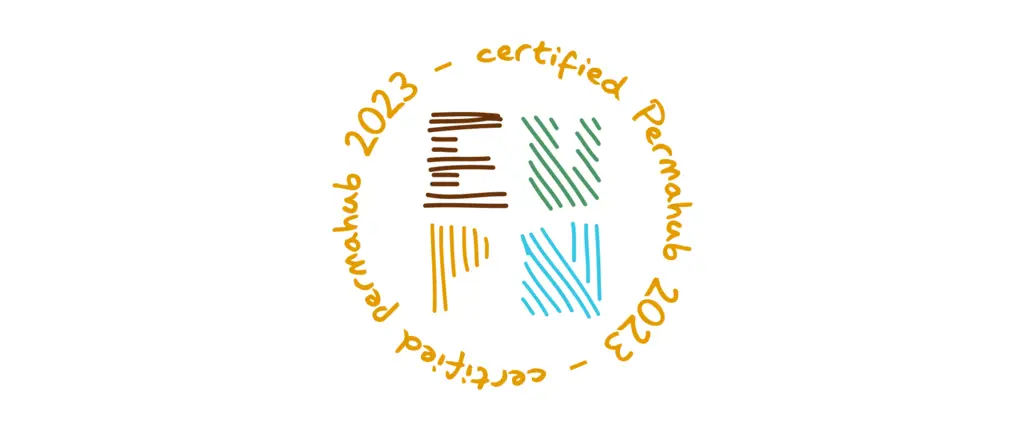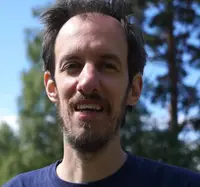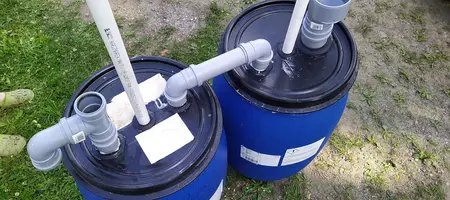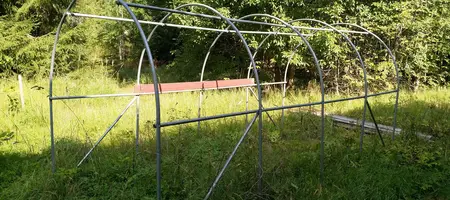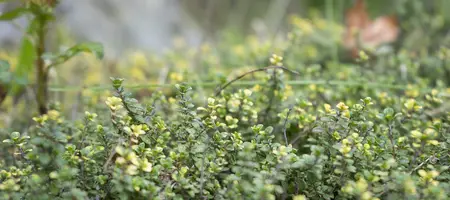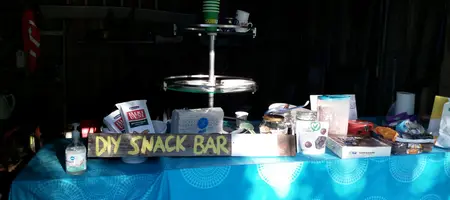The design process used is an experimental one. (I will write about it later).
Permaculture ethics
Earth care: Get projects together which practice and show earth care. Low carbon footprint after implementation.
People care: Give people something simple that shows that they are doing well. A certificate as a base for something they are already doing – and not for additional work on top of what they are already doing. Lift the burden of jumping through several hoops in a process. Establish data driven assessment instead of a complicated assessment process.
Fair share: public knowledge of this design. The ability of everyone to adapt and share this design. Once the design is implemented people can go to the EuPN website and start the certification process.
Observation
From 2016 to 2022 I have been a board member of the Finnish Permaculture Association. From 2019 to 2022 I have also been the president of the Finnish Permaculture Association.
In 2017 Marja Nuora brought the LAND system from Denmark to Finland and the first accredited LAND centre was Koroinen. But then after Koroinen nothing happened – for years. Tärkkilä is after years still a LAND learner and the only other LAND centre is Iso Orvokkiniity – Marja’s place.
LAND is coming from the UK Permaculture Association: “A LAND Centre is a permaculture demonstration site that people can visit to have an experience of permaculture design and techniques in practice. LAND stands for Learning, Action, Network and Demonstration” In UK there are currently (2023) about 40 accredited LAND Centres. The range varies from small garden to farms. They are a place for inspiration.
Since nothing happened in the Finnish Permaculture Association I looked into the LAND design itself and there I found the first problem. I couldn’t find a permaculture design where the outcome was LAND. LAND just was created and there is no documentation about how someone came up with LAND in the first place. In a personal discussion Andy Goldring, the co-orignator of LAND, described it as an undocumented emergent design that he and Chris Evans came up with.
Since LAND has no documented permaculture design and there is no proof of permaculture design tools used we have to work our way back. Basically reverse engineer LAND.
Why be a LAND centre?
The points below are copy & paste from Permaculture Association Britain (PAB).
- Your site mapped on the Permaculture Association website as a recognised place of permaculture practice.
- Attract more visitors and volunteers
- Raises the profile of your project for funding and partnership working
- Lends more credibility to your courses and events
- Becoming part of an active, supportive network
- Support to develop your site to better meet your project aims
- To draw inspiration from the visitors and volunteers that visit you
Requirements of LAND (the whole lot)
- Requirement on the assessing entity
- one to two assessor for a place
- a team of assessors (advisers board)
- a LAND coordinator
- 1 to 2 meetings a year with the LAND centres
- Continuous meetings with the LAND team to develop and coordinate the system
- Requirements on the assessed place
- Required:
- Design Plan & Project Development Goal (a permaculture design)
- PDC Experience (at least one permanent member has a PDC)
- Demonstration Goal (e.g. information sheets, signs, etc)
- Learning Goal (program of permaculture training)
- Resources Goal (learning resources, or other resources, e.g. nursery)
- Volunteers & Visitors Goal (able to receive volunteers and visitors)
- Networks Goal (to have strong connections with relevant networks)
- Health & Safety Goal (appropriate health procedures)
- Network Sharing Goal (profile at a website, share skills and resources
- Monitoring & Evaluation Goal (update the assessing association with information)
- Optional (desired):
- Organisation goal (development, communication, project management)
- Projects & LAND Centres System Goal (to contribute to the development of the LAND system
- Research Goal (program of monitor or research, e.g. visitors and training numbers, outcomes of education activities
- Skill Sharing Goal (to host or help local, regional or national skill sharing)
- Required:
- Requirements of the process
- According to the UK association it is a 7-step process
- Fill in expression of interest form
- Read the LAND criteria and complete self-sevaluation
- Choose a LAND tutor and arrange initial assessments
- Work through all the LAND tutor’s suggestions
- Arrange final assessment with LAND tutor
- Final assessment goes to the LAND advisory board
- Receive confirmation of LAND status
- According to the UK association it is a 7-step process
Imagine how it was when it got developed
Since there is no permaculture design available where the outcome was LAND it is difficult to evaluate it. All what can be done is to imagine how it was.
Let’s step back and think about how LAND get started. Let’s imagine a group of people coming up with LAND.
Person 1: I've been running a permaculture homestead for a few years now, and I really want to find ways to share what we're doing with others in the permaculture community.
Person 2: That's a great idea. I've been thinking about this too. Maybe we could start by creating a directory of permaculture homesteads, farms and teachers, so that people can find out about what's happening in their area.
Person 3: Yes, and we could also create a system for accrediting permaculture places that are doing exemplary work in promoting sustainable land practices and community engagement.
Person 4: Wow, great. We could use the accreditation system to recognize and promote the work of permaculture places that are making a real impact in their communities.
Person 5: And we could also use the accreditation system to incentivize permaculture project owners to seek out training and support in permaculture principles and techniques.
Person 1: Yes, that all sounds great. And we could use the directory and accreditation system to build a sense of community and shared values among permaculture practitioners.
Person 2: And we could promote the directory and accreditation system through social media and other outreach efforts, to build awareness and encourage more people to get involved in permaculture.
Person 3: That's a great idea. And we could also use the accreditation system to track and report on the progress of permaculture centers over time, to measure the impact of permaculture practices and principles on promoting sustainable land management and community building.
Person 4: And we could use the directory and accreditation system to create a platform for knowledge sharing and collaboration among permaculture practitioners.
Person 5: Yes, and we could also use the directory and accreditation system to connect people with opportunities for education and training in permaculture principles and techniques.
Person 1: This is all great stuff. Let's start by creating the directory and accreditation system, and see where it takes us. What do we call it?
Person 2: Let’s call it Centers for Network development and Learning. CeNDL.
Person 3: Let’s call it Center for Learning and Network Development CLAND.
Person 4: Let’s call it LAND centres, Learning and Network Development centres.
The context how it might have happened
Permaculture principles: The concept of permaculture, which emphasizes sustainable land management practices and the integration of natural systems, likely played a role in the development of the LAND system. The principles of permaculture provide a framework for evaluating and promoting sustainable land practices, and may have inspired the development of a system for accrediting LAND centres that adhere to these principles.
Community building: Permaculture is often seen as a community-based practice that values collaboration, sharing, and mutual support. The LAND system may have developed as a way to build and strengthen the permaculture community, by recognizing and promoting LAND centres that are working towards common goals.
Knowledge sharing: Another factor that may have contributed to the development of the LAND system is the desire to share knowledge and best practices in permaculture. By creating a system for accrediting land centres, permaculture practitioners could share their experiences and learn from each other in a structured and organized way.
The dishonesty of purpose
While it is given and said that LAND centrers are to showcase permaculture to the public it is often not about the public but about the community itself. LAND means status among the permaculture places. It means “being better than others, being recognized”. If you ask 1000 random people if they know a LAND centre, probably less than 1% will have an idea. If you ask 1000 random members of Permaculture Britain you might get 50% or more. While it is said to be for the public – it is mostly not. If you tell people outside of the permaculture community in Finland “my place is LAND centre” you will just get the question “What does that mean?”.
It is not working
From a European / UK LAND meeting on the 21st of March 2023 I got the following points:
- there is no more funding for the UK LAND network
- Everywhere: It is a high maintenance system
- The reporting doesn’t work anywhere
- Quality control is not given – the rules get bent often
- The brand is not recognized outside of permaculture
- Assessors have to travel a lot when they need to assess a place – could be hundreds of kilometres
- In some countries there is no support for places that want to become a LAND centre. They just get some documents and that’s it
- LAND doesn’t mean that the places can get any funding. On the other hand sometimes the assessing association is only supporting LAND centres and by that make sure funds are only distributed to those the LAND team & coordinator hand picked
Let’s evaluate what we have so far
| Plus | Minus | Interesting |
| Educational outreach, the requirements could serve as platform for spreading permaculture | Lots of time consumed for assessor, LAND team and the place | Easy to fund, but no funding in several years in different countries |
| Common brand name | No support from the assessing association for the LAND centre (depends on the country) | Open days – could maximize impact |
| The concept is simple enough for funding applications | No financial benefit for the LAND centre (depends on the country) | |
| The concept is simple enough for participants | The administration usually is too rigid and depends on the coordinator (depends on coordinator and team) | |
Community building, being part of a recognized network can help attract more volunteers and visitors
| High carbon footprint in the year of assessment; assessor needs to travel, could be a couple of hundred kilometres per LAND centre | |
| High amount of non-compliance among assessor | ||
| Non-compliance by the accredited LAND centres | ||
| Generally LAND is high maintenance system |
One of the KO criteria for me shown in the PMI is the high maintenance system. In permaculture we usually aim for low maintenance systems. Yet in LAND we defy that principle. Systems and designs that defy their own principles won’t work.
The future – idea
So, what do I want? A system with much less overhead and maintenance than LAND but most of the benefits from the positive of the PMI.
In 2022 I redesigned the EuPN website and by that also the EuPN. Since nearly no one of the old members cared about whether it was working or not I upgraded it to a self-service platform. The key features from the design:
- Self service – everyone can register – there is a check-up to see if people are affiliated with permaculture – you have to provide a link to your website or social media
- Project & places map – everyone can contribute to it
- Events list – everyone can contribute to it
- Teachers directory
- News & newsletter – currently run by editors
There are already a lot of teachers in the database and many of the teachers have added projects and events. There is already a digital footprint – a footprint which could be used to automatically issue a certificate if certain prerequisites happen.
Let’s use the EuPN website as digital certification platform.
Requirements per project / place:
- Active account at the EuPN website
- Project with a project description of more than 600 characters
- Project must have an address
- Project chooses required sustainability practice taxonomy terms
- Project image(s) must to be uploaded
- A teacher must be selected within the project
- The selected teacher’s profile must have the PDC checkbox ticked
- At least 2 events per year per project must be published
- At least 1 news item about the project must be published
- Peer review upon completion of the other requirements
Requirements per software:
- automated checks of all the requirements
- issuing of certificate upon fulfilment
- notification of admin about new issued certificate
- certificate must be unique, downloadable and printable containing a unique number for authenticity check
- revoke of certificate if criteria haven’t been fulfilled
- certificate design must change yearly
Requirements peer review:
- person who runs the review
- 15 to 30 minutes of time for assessor and project owners
- PDC certificate availability of project owner
- Yet to be created questionnaire
- PDC – when, where, Teacher
- Place – when, where, what?
- Place – how do you implement permaculture at your place?
Analysis
Now we analyse the proposal in order to see if something is missing
The proposal would extend the EuPN website. Let’s see if there are already benefits for being a member:
- Networking Opportunities
- Event Notifications
- Directory Listing
- Forums and Discussion Groups (not yet implemented
- Collaboration Opportunities
- Discounts
- News and Updates
- Recognition for projects and places
- Contribution to news and the website in general
- Feedback and Support
In general there are many benefits for being a member of the EuPN.
SWOC
This SWOC is about the EuPN PermaHub certification itself
| Strength | Weaknesses |
Standardization: Provides a consistent framework for permaculture hubs, ensuring a certain level of quality and uniformity. Community Building: Can foster stronger relationships between permaculture practitioners across Europe, leveraging shared resources, insights, and best practices. Visibility: A dedicated Permahub can increase the visibility and credibility of the EuPN and its initiatives. Streamlined Process: Compared to other systems like LAND, the Permahub might offer a more straightforward and efficient certification process. | New System: As a new initiative, there could be initial challenges in its adoption and trustworthiness compared to established systems. Limited Recognition: The Permahub brand is new and might not have the recognition that other systems enjoy, like LAND in the UK. Potential Overlap: There might be some redundancy or overlap with existing systems, which could cause confusion or dilution of efforts. |
| Opportunity | Challenges |
Broad Adoption: If successfully implemented, the Permahub can become a widely-accepted standard for permaculture hubs across Europe. Digital Integration: There's a chance to integrate modern technologies to enhance and streamline the certification process and member communication. Collaborative Events: The Permahub could become a central point for hosting and promoting events, workshops, and courses, further enhancing the community feeling. | Gaining Trust: Convincing permaculture practitioners and hubs to adopt and trust this new system over others. Logistics: Ensuring that the certification process, while streamlined, remains rigorous and maintains high standards. Resource Allocation: Allocating sufficient resources (time, money, personnel) to develop, maintain, and promote the Permahub initiative. |
PMI
A small PMI based on the outlines described in “The future”
Plus (+)
Streamlined Process: Permahub's emphasis on leveraging digital footprints can make the certification process smoother and less tedious compared to the intricate requirements of LAND.
Scalability: Given its digital nature, the Permahub system might be more easily scalable across different regions and languages.
Technological Integration: By using technology to validate and certify hubs, there's potential for continuous innovation and adaptability.
Inclusivity: Permahub could be more inclusive for regions where LAND is less recognized or has linguistic and cultural challenges.
Minus (-)
Dependency on Digital: Hubs with limited digital connectivity or skills may find it challenging to meet Permahub requirements.
Possibility of Overlooking On-Ground Realities: A digital-centric approach might sometimes overlook the nuances of on-ground permaculture practices and their local relevance.
New System: Being a new system, it may take time to gain the recognition and trust that LAND has established over time.
Interesting (I)
Integration with Existing Systems: How will Permahub integrate or coexist with established systems like LAND?
Evolution over Time: How will the criteria and technology for Permahub evolve with changing needs and technological advancements?
User Feedback and Iteration: How will feedback from hubs be integrated to improve and refine the Permahub system?
Global Applicability: Could the Permahub model, if successful in Europe, be adopted or adapted for other regions of the world?
6 thinking hats
If I were to embody the perspective of a homestead owner interested in the EuPN PermaHub and run through Edward de Bono's Six Thinking Hats method, it might look something like this:
1. White Hat (Facts and Information):
What do I know? The EuPN PermaHub is a streamlined certification process that leverages digital footprints and aims to provide recognition for permaculture projects and initiatives.
How does it work? The process emphasizes a digital-first approach, offering potential scalability across regions and languages.
2. Red Hat (Feelings and Intuition):
How do I feel about it? Optimistic and curious. The idea of getting recognized without the lengthy LAND accreditation process is appealing.
Concerns: I hope the digital emphasis doesn't mean the intrinsic qualities of my homestead are overlooked.
3. Black Hat (Judgment and Caution):
Potential issues: Will the EuPN PermaHub be recognized as widely as LAND? Could the streamlined process lead to a dilution of standards? Does a digital focus mean the real-world, tangible elements of my homestead might be undervalued?
4. Yellow Hat (Benefits):
Pros: The streamlined process could save time. The scalability could mean that as the system grows, the recognition and value of being a PermaHub increase. The digital emphasis might provide new ways of showcasing the homestead, connecting with a wider audience, and gaining recognition.
5. Green Hat (Creativity):
Potential opportunities: This could be a chance to pioneer a new wave of permaculture recognition, leading the way for other homesteads. There might be opportunities to provide feedback and shape the PermaHub process based on my experiences.
6. Blue Hat (Process and Control):
Next steps: Research more on the exact criteria and process for PermaHub. Perhaps reach out to the EuPN for detailed information, discuss with other homestead owners, and weigh the pros and cons before making a decision.
Decision
I haven’t seen any show stopper in the analysis stage of the proposal. None of the tools revealed anything out of the ordinary. I had a discussion with homestead owners and so far it seems to be positive. What I’m going to do now is to check against the Permaculture design principles.
Observe and Interact: Done
Catch and store energy: Digital information like projects and places are caught and stored energy
Obtain a yield: Popularity of the platform, more people visiting,
Apply Self-regulation and accept feedback: I have to see where it goes and listen to the EuPN member
Use and value renewable resources and services: the basis for the EuPN website is Cathedral, a Drupal distribution developed by my company Chase & Snow Oy. It can be used over and over again for other projects
Produce no waste: so far no waste but unclear yet. Has to be evaluated after years
Design from patterns to details: we haven’t established any pattern yet
Integrate rather than segregate: the PermaHub should allow all permaculture practitioners in Europe to have an account.
Use small and slow solutions: There will be no social media
Use and value diversity: This is more for the community. The PermaHub certificate will offer an addition to the existing system
Creatively use and respond to change: hmm
After checking against the principles I see no harm and no problem. It is now for implementation
Implementation
| What | Hours |
| Code the module that checks for the requirements and then issues the certificate | 40 |
| Design a certificate | 1 |
| Test run the certification process | 5 |
| Test print the certificate | 0.15 |
| Check with colleagues about the peer review process | 3 |
| Write a “press release” for the EuPN website introducing the PermaHub certificate | 1 |
| Create a landing page with all the information about the PermaHub | 1 |
During the implementation phase I realised that some of the criteria might not be useful or actually practical. Therefore I change them:
- Have an account at this website.
- Have a project with all the required fields filled in.
- Have at least 2 events per year associated with the project (either within the past 12 months or within the current calendar year).
- Have an associated user in your project with the “PDC” field ticked in their profile.
Evaluation
So far there is only one EuPN certified PermaHub: Beyond Buckthorns. But it is only a matter of time until more places have added enough data to be accredited. With the EuPN certified PermaHub we have streamlined the accreditation process and lifted it into the digital age. No paperwork needed. No travel for assessors. The time is reduced to creating a project node, which is depending on the amount of information between 2 to 10 minutes. The time for creating 2 events is about 2 to 10 minutes. To update account information takes between 2 to 10 minutes. In total it requires between 6 to 30 minutes to have all data in the system in order to be accredited. But here comes the multiple function per important element principle in: It is not just for the certificate it is also for the viability of the project and courses / events. The account is required to take part in the monthly EuPN members calls which is a get-together of the members to get to know each other.
I come back to this design in some years in order to run a proper evaluation.

